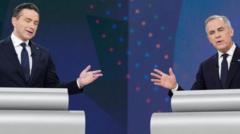The leaders of Canada’s four major federal parties convened for their second and final debate ahead of this month’s general election, with much of the attention focused on both domestic politics and the influence of US President Donald Trump. The main query leading into the debate revolved around whether Liberal leader Mark Carney, currently ahead in the polls, would falter under pressure. Carney, having previously navigated a French debate, faced significant scrutiny from his rivals: Conservative leader Pierre Poilievre, New Democratic Party leader Jagmeet Singh, and Bloc Québécois leader Yves-Francois Blanchet.
Discussions included how to address the ongoing US-Canada trade tensions, coupled with other critical issues such as affordability, crime, and environmental policies. Here are five significant takeaways from Thursday’s event:
1. **Haunted by Trudeau's Legacy:** Opponents seized upon the shortcomings of Carney's predecessor, Justin Trudeau. Poilievre criticized the Liberal decade of governance concerning issues like housing and living costs, challenging Carney, “How can we possibly believe you are any different?” Blanchet also called for proof of Carney's divergence from Trudeau, leading Carney to assert his distinctiveness and clarify that he has only recently assumed the prime ministerial role.
2. **Negotiating with Trump:** When queried on handling Trump’s tariffs, which impose substantial fees on Canadian goods, leaders expressed a stark realization of the economic disparity. Carney remarked, “We’ve moved on from dollar-for-dollar tariffs,” indicating a shift towards more strategic responses to mitigate potential fallout from US policies, even mentioning recent constructive dialogues with Trump.
3. **Policy Nuances at Play:** Delving into pressing national issues, the debate showcased distinct perspectives on crucial topics: Poilievre emphasized limited government and low taxes for growth, while Singh highlighted the need for enhanced social programs and healthcare. Carney’s centrist views contrasted with Blanchet’s focus on Quebec’s identity and unique political standing.
4. **Struggle for Relevance:** With the Canadian political landscape reflecting multiple party options, the third-place parties, notably the New Democrats, are battling for electoral viability; current polls suggest significant declines in their seat expectations. Singh actively sought to differentiate his party’s platform as he interrupted rivals to advocate for left-wing values.
5. **Civil Engagement Displayed:** Despite the exchanges becoming spirited, the overall tone among leaders was notably courteous. Carney, when challenged by Poilievre, chose to restrain himself mid-sentence, displaying an effort toward maintaining a polite discourse. The leaders’ post-debate interactions—shaking hands and sharing camaraderie—further contrasted with the often-contentious environment of political debates in the US.
As the election approaches, these interactions highlight the vivid choices facing Canadian voters, setting the stage for what promises to be a closely watched contest.



















